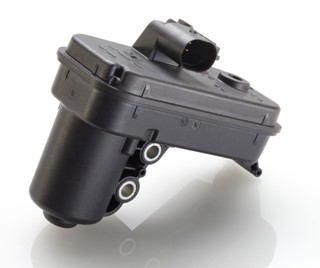The housing of the latest waste gate actuator series from HELLA KGaA Hueck & Co. is based on VESTAMID® HTplus, the polyphthalamide from Evonik Resource Efficiency GmbH, Essen (Germany).
 The 2-part actuator housing from HELLA KGaA Hueck & Co. made from VESTAMID® HTplus combines high temperature resistance, good mechanical properties, and very good chemical resistance. The components are welded together by laser.
The 2-part actuator housing from HELLA KGaA Hueck & Co. made from VESTAMID® HTplus combines high temperature resistance, good mechanical properties, and very good chemical resistance. The components are welded together by laser.
The component is used at a temperature of 160 degrees Celsius and is easily able to withstand the challenging ambient conditions in the engine compartment. A well-known German automobile manufacturer has been employing the actuators in its production lines since October 2014.
The actuator housing consists of a main body and a cover that are welded together using a laser. This is possible due to the different material properties of the components: the cover is made from a specially developed laser-transparent VESTAMID® HTplus M1034, while the body is made from the laser-absorbing grade VESTAMID® HTplus M1634. Laser welding has several advantages over the more commonly used ultrasonic welding: no damage to internal electronic components, homogeneity, narrow heating zone, high welding seam strength, and no welding spatter in the housing.
Both housing components are reinforced with 40 percent glass fiber and, in addition to high temperature resistance, they are also very rigid and strong, they have good dimensional stability, and they exhibit very good chemical resistance. Udo Wallmeier, the materials expert for polymers at HELLA, very much appreciates this combination of good mechanical and thermal properties along with the fact that the components can be laser welded: “VESTAMID® HTplus fulfills all the requirements for our actuator series. Consequently, the polyphthalamide from Evonik is the ideal material for our application.”
Waste gate actuators control the flow of gas inside the turbo charger. The actuators from HELLA are extremely precise across a wide temperature range, and are very robust and reliably designed components.
Discover more about the high performance polymers from Evonik at our stand 4117 in Hall 4 at FAKUMA in Friedrichshafen, Germany, from October 13 to 17.